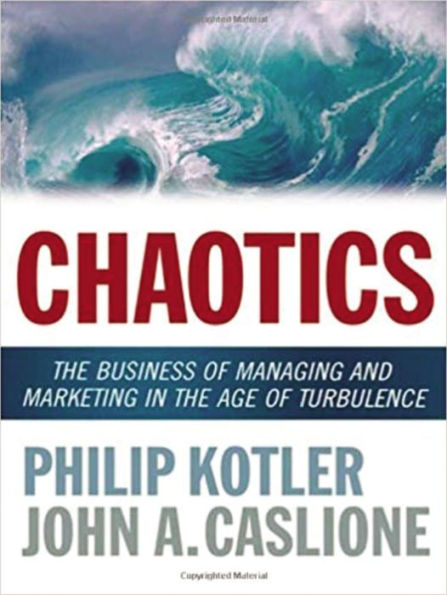As the fallout from the financial meltdown of 2008 grows progressively worse, companies, industries, and entire markets cling precariously to life or have ceased to exist altogether. And the turbulence may not be over any time soon.
In Chaotics, noted business strategists Philip Kotler and John Caslione present the intriguing, if unsettling, argument that these troubled times are not an aberration, but the new face of normal. In fact, the economic downturn is part of a continually oscillating Age of Turbulence, where both risk and opportunity are quickly felt around the world, now inexorably linked by globalism and technology. It’s a world that chews up the unprepared, but rewards the prepared—those robust companies that have the ability to quickly anticipate and effectively respond to potential threats.
Packed with illuminating examples of resilient companies that are successfully navigating turbulence, as well as many painful examples of bankrupt or soon-to-be defunct companies unprepared for the chaos that felled them, Chaotics provides deep insights and practical strategies for not only surviving the current economic downturn, but also thriving amid the many slumps and spurts of prosperity that lie ahead.
At the heart of this book is an innovative Chaotics Management System for minimizing vulnerability and exploiting opportunities—and putting yourself way ahead of your competitors, most of whom are clinging to the same old panic tactics of across-the-board staff cuts, deep price discounts, and slashed investments in marketing, branding, and new product development. The system outlined here helps you completely rethink how you manage and market during recession and other turbulent conditions, including how to:
- Develop early warning systems for identifying the first signs of upheaval, including disruptive innovations and shocks
- Construct detailed worst-case, best-case, and most-expected-case scenarios using the strategies for effectively dealing with each
- Cut costs or enhance efficiency strategically in specific departments: finance, information technology, manufacturing, purchasing, and human resources
- Secure your market share from core customer segments—without decimating customer research and marketing budgets
- Compress strategic planning into shorter, three-month time cycles to keep a closer read on the pulse of the company
- Prevent the potentially catastrophic consequences of abandoning core principles
Timely, practical, and compelling, Chaotics is an indispensable guide for business leaders striving to survive today’s economic storms and to prosper through the inevitable turbulence of tomorrow.
As the fallout from the financial meltdown of 2008 grows progressively worse, companies, industries, and entire markets cling precariously to life or have ceased to exist altogether. And the turbulence may not be over any time soon.
In Chaotics, noted business strategists Philip Kotler and John Caslione present the intriguing, if unsettling, argument that these troubled times are not an aberration, but the new face of normal. In fact, the economic downturn is part of a continually oscillating Age of Turbulence, where both risk and opportunity are quickly felt around the world, now inexorably linked by globalism and technology. It’s a world that chews up the unprepared, but rewards the prepared—those robust companies that have the ability to quickly anticipate and effectively respond to potential threats.
Packed with illuminating examples of resilient companies that are successfully navigating turbulence, as well as many painful examples of bankrupt or soon-to-be defunct companies unprepared for the chaos that felled them, Chaotics provides deep insights and practical strategies for not only surviving the current economic downturn, but also thriving amid the many slumps and spurts of prosperity that lie ahead.
At the heart of this book is an innovative Chaotics Management System for minimizing vulnerability and exploiting opportunities—and putting yourself way ahead of your competitors, most of whom are clinging to the same old panic tactics of across-the-board staff cuts, deep price discounts, and slashed investments in marketing, branding, and new product development. The system outlined here helps you completely rethink how you manage and market during recession and other turbulent conditions, including how to:
- Develop early warning systems for identifying the first signs of upheaval, including disruptive innovations and shocks
- Construct detailed worst-case, best-case, and most-expected-case scenarios using the strategies for effectively dealing with each
- Cut costs or enhance efficiency strategically in specific departments: finance, information technology, manufacturing, purchasing, and human resources
- Secure your market share from core customer segments—without decimating customer research and marketing budgets
- Compress strategic planning into shorter, three-month time cycles to keep a closer read on the pulse of the company
- Prevent the potentially catastrophic consequences of abandoning core principles
Timely, practical, and compelling, Chaotics is an indispensable guide for business leaders striving to survive today’s economic storms and to prosper through the inevitable turbulence of tomorrow.

Chaotics: The Business of Managing and Marketing in the Age of Turbulence
224
Chaotics: The Business of Managing and Marketing in the Age of Turbulence
224eBook (Digital original)
Related collections and offers

